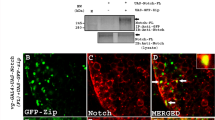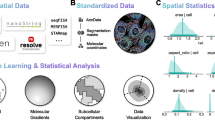Abstract
The normal translocation of nascent polypeptides into the lumen of the endoplasmic reticulum (ER) is thought to be aided in part by a translocon-associated protein (TRAP) complex consisting of 4 protein subunits. The association of mature proteins with the ER and Golgi, or other intracellular locales, such as lysosomes, depends on the initial targeting of the nascent polypeptide to the ER membrane. A similar scenario must also exist for proteins destined for secretion. We have identified a member of the TRAP complex using a two hybrid screen to isolate proteins that bind to zebrafish (Danio) Ran binding protein 1. The polypeptide predicted from the largest open reading frame contains 183 amino acids with a 86 and 87% sequence identity to the TRAPβ subunits in human and chicken, respectively. Sequence analysis identified a cleavable amino-terminal signal peptide in the zebrafish TRAPβ subunit and a region of the protein spans the membrane of the endoplasmic reticulum. A reverse transcriptase-polymerase chain reaction assay showed that TRAPβ mRNA is expressed in the developing zebrafish embryo. TRAPβ mRNA is maternally supplied to the egg and is expressed constitutively throughout development and in the adult. This pattern of expression indicates that the message encoding part of the machinery targeting nascent polypeptides to the ER lumen is available at the onset of embryogenesis when the rate of translation increases exponentially over that occurring in the oocyte. In situ hybridization was used to test whether or not TRAPβ transcripts might become localized and/or enriched in the developing embryo. Homogeneous staining is seen in the blastula and early gastrula stages. At mid-to-late gastrula stages, however, the message becomes enriched in the developing notochord and polster, or hatching gland rudiment. The TRAPβ gene, mapped using the LN54 mouse-zebrafish radiation hybrid panel to linkage group 19, resides next to a gene (Z15451) which has sequence homology to notch2 and vascular endothelial growth factor. TRAPβ, however, does not appear to belong to a group of genes which are syntenic with orthologues or paralogues on human chromosomes.
Similar content being viewed by others
References
Blobel G, Dobberstein B: Transfer of proteins across membranes. I. Presence of proteolytically processed and unprocessed nascent immunoglobulin light chains on membrane bound ribosomes of murine myeloma. J Cell Biol 67: 835–851, 1975
Rapoport TA: Transport of proteins across the endoplasmic reticulum membrane. Science 258: 931–936, 1992
Walter P, Lingappa VR: Mechanism of protein translocation across the endoplasmic reticulum membrane. Annu Rev Cell Biol 2: 499–516, 1986
Rapoport T, Jungnickel B, Kutay U: Protein transport across the eukaryotic endoplasmic reticulum and bacterial inner membranes. Annu Rev Biochem 65: 271–303, 1996
Beckmann R, Bubeck D, Grassucci R, Penczek P, Verschoor A, Blobel G, Frank J: Alignment of conduits for the nascent polypeptide chain in the ribosome-Sec61 complex. Science 278: 2123–2125, 1997
Wang L, Dobberstein B: Oligomeric complexes involved in translocation of proteins across the membrane of the endoplasmic reticulum. FEBS Lett 457: 316–322, 1999
Gö rlich D, Prehn S, Hartmann E, Herz J, Otto A, Kraft R, Wiedmann M, Knespel S, Dobberstein B, Rapoport TA: The signal sequence receptor has a second subunit and is part of a translocation complex in the endoplasmic reticulum as probed by bifunctional reagents. J Cell Biol 111: 2283–2294, 1990
Hartmann E, Gö rlich D, Kostka S, Otto A, Kraft R, Knespel S, Bü rger E, Rapoport TA, Prehn S: A tetrameric complex of membrane proteins in the endoplasmic reticulum. Eur J Biochem 214: 375–381, 1993
Wada I, Rindress D, Cameron PH, Ou W-J, Doherty JJ II, Louvard D, Bell AW, Dignard D, Thomas DY, Bergeron JJM: SSRa and associated calnexin are major calcium binding proteins of the endoplasmic reticulum membrane. J Biol Chem 266: 19599–19610, 1991
Hirama T, Miller CW, Koeffler HP: Translocon-associated protein a transcripts are induced by granulocyte-macrophage colony-stimulating factor and exhibit complex alternative polyadenylation. FEBS Lett 455: 223–227, 1999
Kunst CB, Mezey E, Brownstein MJ, Patterson D: Mutations in SOD1 associated with amyotrophic lateral sclerosis cause novel protein interactions. Nat Genet 15: 91–94, 1997
Mangos S, Vanderbeld B, Krawetz R, Sudol K, Kelly GM: The Ran binding protein RanBP1 in zebrafish embryonic development. Mol Rep Dev,2000 (accepted)
Rubinstein AL, Lee D, Luo R, Henion PD, Halpern ME. Genes dependent on zebrafish cyclops function identified by AFLP differential gene expression screen. Genesis 26: 86–97, 2000
Melby AE, Kimelman D, Kimmel CB. Spatial regulation of floating head expression in the developing notochord. Dev Dyn 209: 156–165, 1997
Gietz RD, Schiestl RH: Transforming yeast with DNA. Meth Mol Cell Biol 5: 255–269, 1995
Kelly GM, Reversade B: Characterization of a cDNA encoding a novel band 4.1-like protein in zebrafish. Biochem Cell Biol 75: 623–632, 1997
Schulte-Merker S, VanEeden FJM, Halpern ME, Kimmel CB, Nü sslein-Volhard C. No tail (ntl) is the zebrafish homologue of the mouse T (Brachyury) gene. Development 120: 1009–1015, 1994
Jowet T: Analysis of protein and gene expression. Meth Cell Biol 59: 63–85, 1999
Hukriede N, Joly L, Tsang M, Miles J, Tellis P, Epstein J, Barbazuk WB, Li FN, Paw BH, Postlethwait JH, Hudson TJ, Zon LI, McPherson JD, Chevrette M, Dawid I, Johnson SL, Ekker M: Radiation hybrid mapping of the zebrafish genome. Proc Natl Acad Sci USA 96: 9745–9750, 1999
Kimmel CB, Ballard WW, Kimmel SR, Ullmann B, Schilling TF: Stages of embryonic development of the zebrafish. Dev Dynamics 203: 253–310, 1995
Altschul SF, Madden TL, Schä ffer AA, Zhang J, Zhang Z, Miller, W, Lipman DJ: Gapped BLAST and PSI-BLAST: A new generation of protein database search programs. Nucl Acids Res 25: 3389–3402, 1997
Vogel F, Hartmann E, Gö rlich D, Rapoport TA: Segregation of the signal sequence receptor protein in the rough endoplasmic reticulum membrane. Eur J Cell Biol 53: 197–202, 1990
Kane DA, Kimmel CB: The zebrafish midblastula transition. Development119: 447–456, 1993
Kelly GM, Greenstein P, Erezyilmaz DF, Moon RT: Zebrafish wnt8 and wnt8b share a common activity but are involved in distinct developmental pathways. Development 121: 1787–1799, 1995
Vascotto S, Beckham Y, Kelly GM: The zebrafish's swim to fame as an experimental model in biology. Biochem Cell Biol 75: 479–485, 1997
Postlethwait JH, Yan YL, Gates MA, Horne S, Amores A, Brownlie A, Donovan A, Egan ES, Force A, Gong Z, Goutel C, Fritz A, Kelsh R, Knapik E, Liao E, Paw B, Ransom D, Singer A, Thomson M, Abduljabbar TS, Yelick P, Beier D, Joly JS, Larhammar D, Rosa F, Westerfield M, Zon LI, Johnson SL, Talbot WS, Ekker M: Vertebrate genome evolution and the zebrafish gene map. Nat Genet 18: 345–349, 1998
Chinen K, Sudo K, Takahashi E, Nakamura Y: Isolation and mapping of the human beta-signal sequence receptor gene (SSR2). Cytogenet Cell Genet 70: 215–217, 1995
Gates MA, Kim L, Egan ES, Cardozo T, Sirotkin HI, Dougan ST, Lashkari D, Abagyan R, Schier AF, Talbot WS: A genetic linkage map for zebrafish: Comparative analysis and localization of genes and expressed sequences. Genome Res 9: 334–347, 1999
Bodescot M, Brison O: Cloning and sequence analysis of the β subunit of the human translocon-associated protein. Biochim Biophys Acta 1217: 101–102, 1994
Zarkadis I, Vezyri E, Kouvelas E, Thanos D, Papamatheakis J, Athanassiadou A: cDNA cloning of the translocon associated protein β-subunit in the chicken cerebellum. Gene 201: 1–4, 1997
Author information
Authors and Affiliations
Rights and permissions
About this article
Cite this article
Mangos, S., Krawetz, R. & Kelly, G.M. The translocon-associated protein β in zebrafish embryogenesis. I. Enhanced expression of transcripts in notochord and hatching gland precursors. Mol Cell Biochem 215, 93–101 (2000). https://doi.org/10.1023/A:1026598516681
Issue Date:
DOI: https://doi.org/10.1023/A:1026598516681




